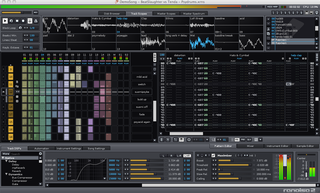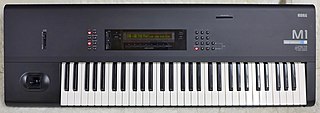A music sequencer is a device or application software that can record, edit, or play back music, by handling note and performance information in several forms, typically CV/Gate, MIDI, or Open Sound Control (OSC), and possibly audio and automation data for DAWs and plug-ins.
A software synthesizer, also known as a softsynth, or software instrument is a computer program, or plug-in that generates digital audio, usually for music. Computer software that can create sounds or music is not new, but advances in processing speed now allow softsynths to accomplish the same tasks that previously required the dedicated hardware of a conventional synthesizer. Softsynths are usually cheaper and more portable than dedicated hardware, and easier to interface with other music software such as music sequencers.

GarageBand is a line of digital audio workstations for macOS and iOS devices that allows users to create music or podcasts. GarageBand is developed and sold by Apple for macOS, and is part of the iLife software suite. Its music and podcast creation system enables users to create multiple tracks with pre-made MIDI keyboards, pre-made loops, an array of various instrumental effects, and voice recordings.

A scorewriter, or music notation program is software used with a computer for creating, editing and printing sheet music. A scorewriter is to music notation what a word processor is to text, in that they both allow fast corrections (undo), flexible editing, easy sharing of electronic documents, and clean, uniform layout. In addition, most scorewriters, especially those from the 2000s, are able to record notes played on a MIDI keyboard, and play music back via MIDI or virtual instruments. Playback is especially useful for novice composers or music students or when no musicians are readily available or affordable.

A digital audio workstation (DAW) is an electronic device or application software used for recording, editing and producing audio files. DAWs come in a wide variety of configurations from a single software program on a laptop, to an integrated stand-alone unit, all the way to a highly complex configuration of numerous components controlled by a central computer. Regardless of configuration, modern DAWs have a central interface that allows the user to alter and mix multiple recordings and tracks into a final produced piece.

Rosegarden is a free software digital audio workstation program developed for Linux with ALSA and Qt4. It acts as an audio and MIDI sequencer, scorewriter and musical composition and editing tool. It is intended to be a free alternative to such applications as Cubase.

Renoise is a digital audio workstation (DAW) based upon the heritage and development of tracker software. Its primary use is the composition of music using sound samples, soft synths, and effects plug-ins. It is also able to interface with MIDI and OSC equipment. The main difference between Renoise and other music software is the characteristic vertical timeline sequencer used by tracking software.

The Korg M1 is a 16-voice, 8-part multitimbral sample-based synthesizer and music workstation, manufactured by Korg from 1988 to 1995. The M1 features a MIDI sequencer and a wide palette of available sounds, allowing for the production of complete musical arrangements. Outselling the Yamaha DX7 and Roland D-50, the M1 became the top-selling digital synthesizer of its time.

Logic Pro is a digital audio workstation (DAW) and MIDI sequencer software application for the macOS platform. It was originally created in the early 1990s as Notator Logic, or Logic, by German software developer C-Lab, later Emagic. It became an Apple product, eventually known as Logic Pro, after Apple bought Emagic in 2002. It is the 2nd most popular DAW according to a survey conducted in 2015.
Tracktion is a digital audio workstation for recording and editing audio and MIDI. The software is cross-platform, running on Apple Mac OS X, Microsoft Windows and Linux.

LMMS is a digital audio workstation application program. When LMMS is executed on a computer with appropriate hardware, it allows music to be produced by arranging samples, synthesizing sounds, playing on a MIDI keyboard and combining the features of trackers and sequencers. It supports the Linux Audio Developer's Simple Plugin API (LADSPA) and partially Virtual Studio Technology (VST) plug-ins. It is free software released under the GNU General Public License, version 2 (GPLv2).

Ubuntu Studio is a recognized flavor of the Ubuntu Linux distribution, which is geared to general multimedia production. The original version, based on Ubuntu 7.04, was released on 10 May 2007.
FluidSynth, formerly named iiwusynth, is a free open source software synthesizer which converts Musical Instrument Digital Interface (MIDI) note data into an audio signal using SoundFont technology without need for a SoundFont-compatible soundcard. FluidSynth can act as a virtual MIDI device, able to receive MIDI data from any program and transform it into audio on-the-fly. It can also read in SMF (.mid) files directly. On the output side, it can send audio data directly to an audio device for playback, or to a Raw or Wave file. It can also convert a SMF file directly to an audio file in faster-than-real-time. The combination of these features gives FluidSynth the following major use cases:
Seer Systems developed the world's first commercial software synthesizer in the early 1990s. Working in conjunction with Intel, then Creative Labs, and finally as an independent software developer and retailer, Seer helped lay the groundwork for a major shift in synthesis technology: using personal computers, rather than dedicated synthesizer keyboards, to create music.
WildMIDI is a free open-source software synthesizer which converts MIDI note data into an audio signal using GUS sound patches without need for a GUS patch-compatible soundcard. WildMIDI, whose aim is to be as small as possible and easily portable, started in December 2001, can act as a virtual MIDI device, capable of receiving MIDI data from any program and transforming it into audio on-the-fly. It is the standard MIDI renderer for the GStreamer framework.








